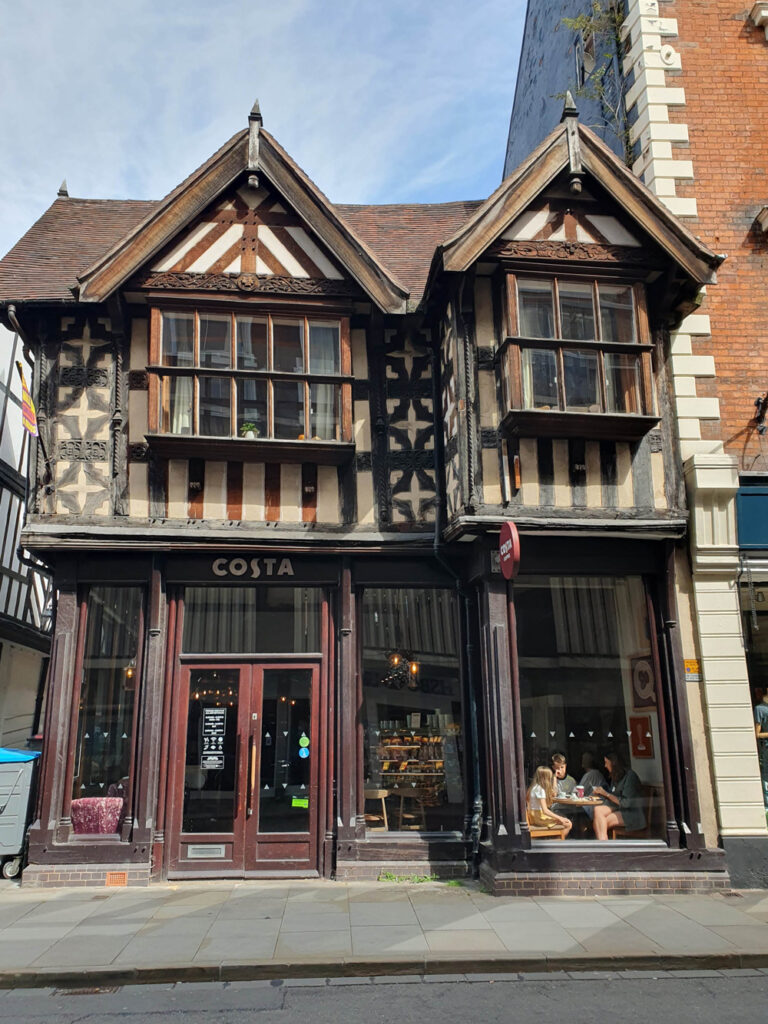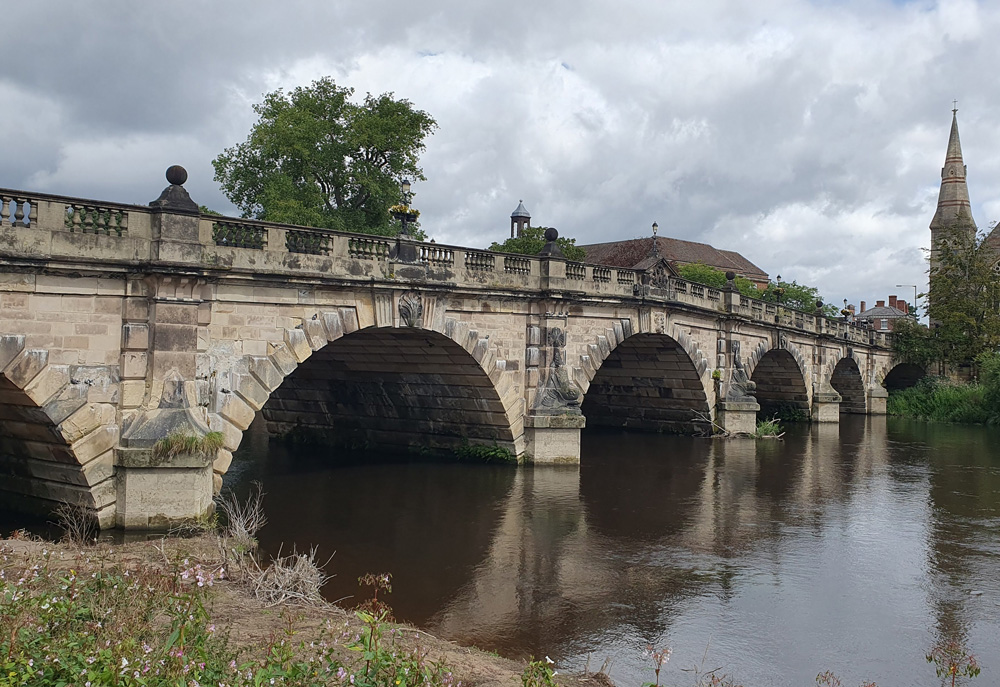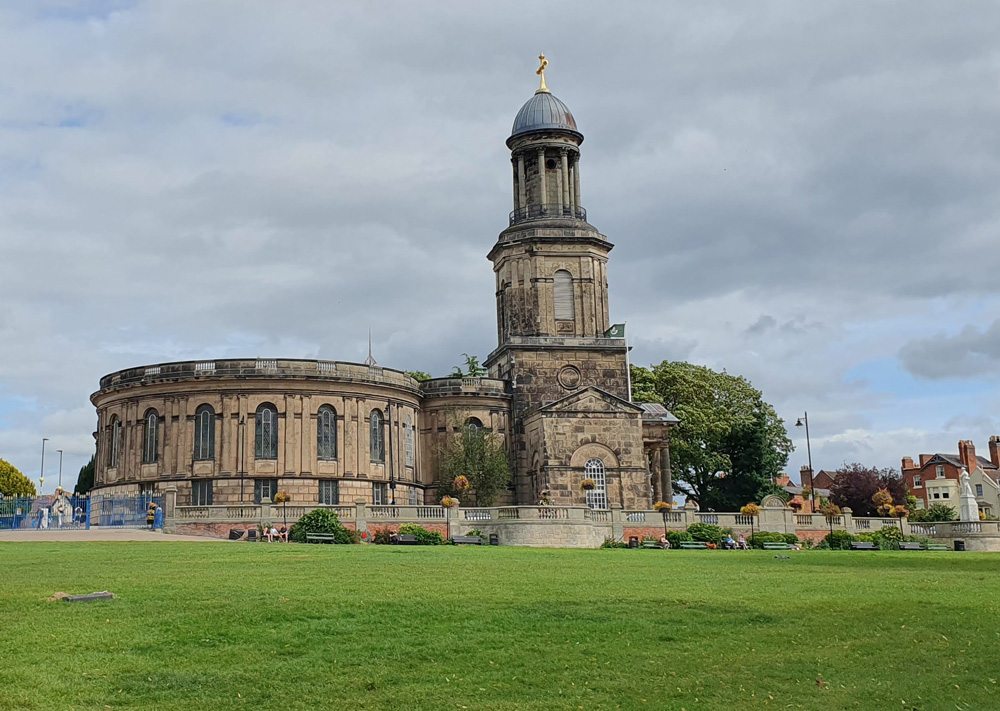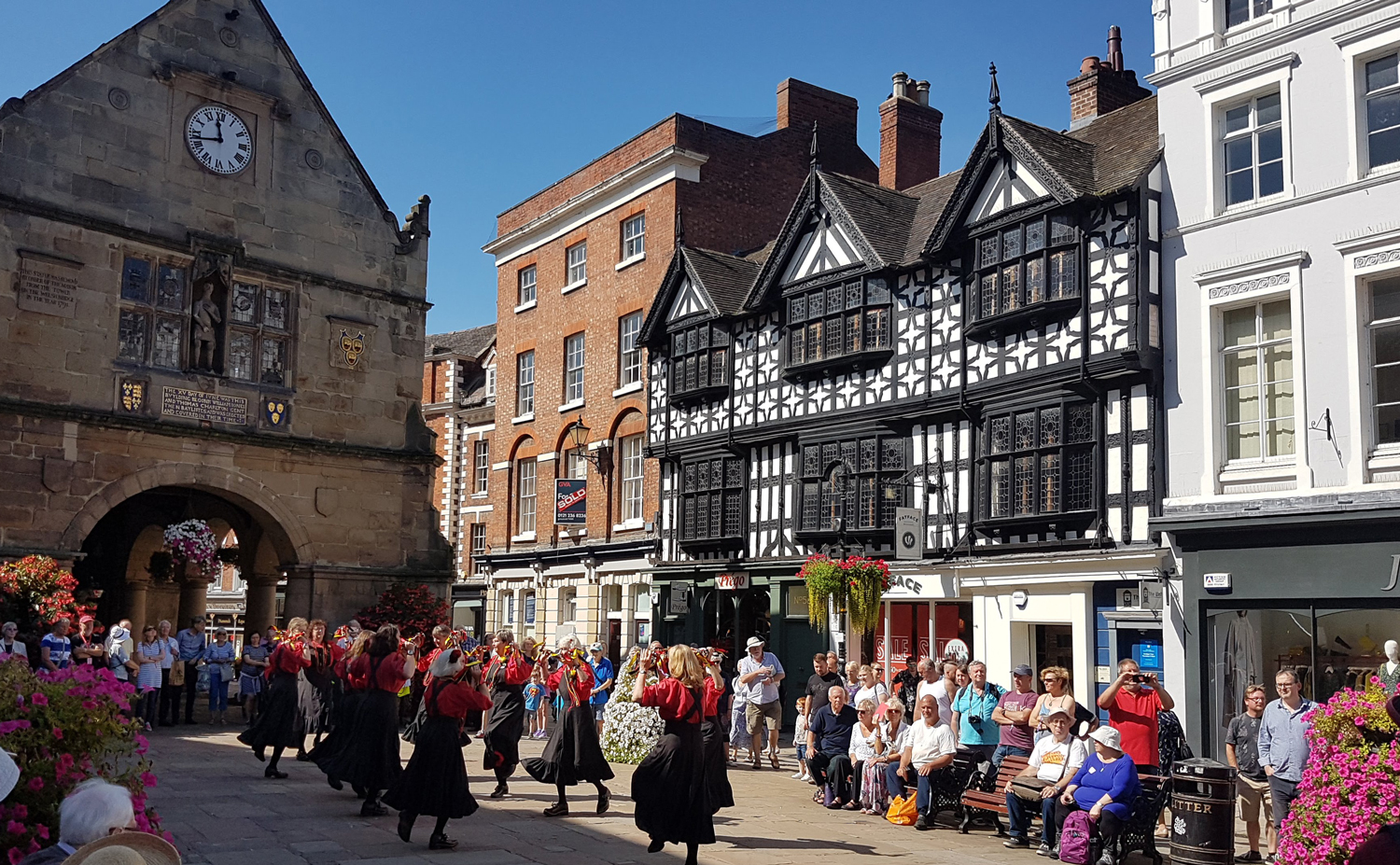Shrewsbury tourist information
Shrewsbury, Shropshire’s county town, is a historic and handsome town with a country feel. It’s a good choice for a short break, with a welcoming atmosphere and several interesting tourist sights as well as a great range of independent shops and places to eat. With decent transport connections, Shrewsbury also makes a convenient base for a longer stay, seeing more of the surrounding area. If you’re visiting on a day trip, it’s easy to get around on foot and plan a day filled with variety as well as foodie treats.
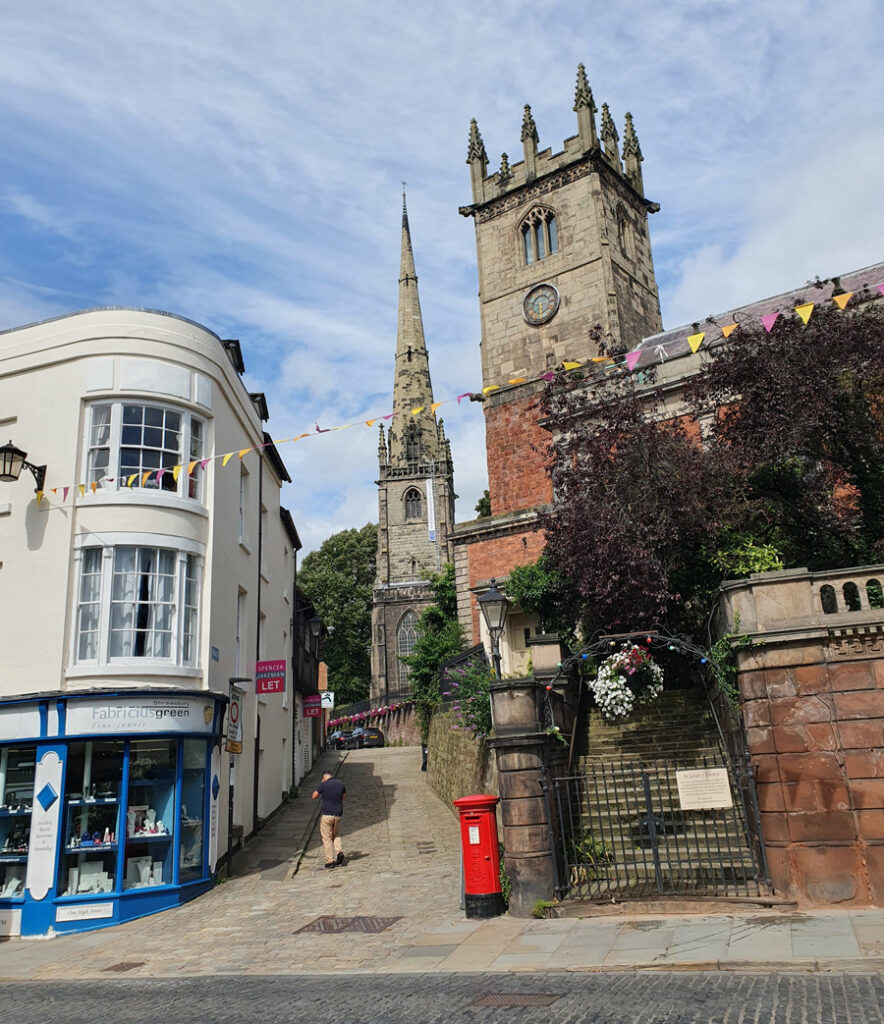
Why visit Shrewsbury?
Shrewsbury’s centre is both small and fairly unspoilt, despite its status as a county town. With a population of 76,000, it’s significantly smaller than nearby Telford, which has attracted more modern developments. Like Shropshire in general, Shrewsbury is something of a hidden gem; relatively under-the-radar to outsiders. Although very welcoming to visitors (with free maps available outside the station), the town doesn’t have the ‘touristy’ overburdened feel that so many destinations struggle with nowadays. For me, it’s just the right balance of tourist-friendly and authentically ‘local’ in character. And there’s a good choice of things to do without the options being overwhelming.
History and background
The easily-defensible position of this old hill-town, in a tight curve of the river Severn close to the Welsh border led to population growth and prosperity for early Shrewsbury. To this day, Shrewsbury has an English Bridge and a Welsh Bridge crossing the Severn, underlining its strategic border location. As with much of medieval Europe, religion played a big part in Shrewsbury’s development. And one of its religious foundations has gained extra fame in recent decades through fiction: Cadfael, detective hero of Ellis Peters’s novels and the 1990s TV series, is a 12th-century Benedictine monk at Shrewsbury Abbey.
The lack of major urban re-developments over recent centuries has meant Shrewsbury still has a centre dotted with fine old buildings, many of them black and white. You may find a half-timbered Jacobean town house, or a terrace of elegant Georgian homes. Walk along a stretch of the old defensive wall and peer over to see little allotments, fig trees and green sports fields.
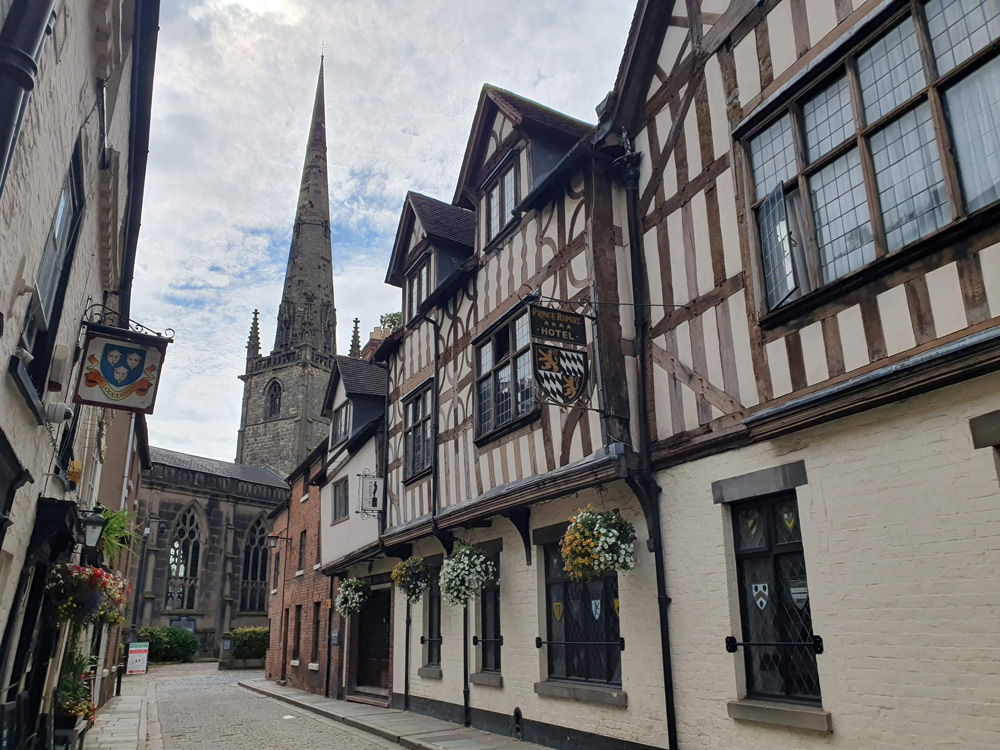
What to see and do
First and foremost, Shrewsbury is an enjoyable town to stroll around. Explore the sloping streets and winding alleys lined with historic buildings, many of them picturesquely black-and-white and some quaintly wonky. You can start off with a map (free from the station and museum) or pick up a walking trail leaflet for a more in-depth experience.
Shrewsbury Museum and Art Gallery is unmissable if you have any interest in the area’s archaeology, history, culture or geology. Free to visit, and with lots of family-friendly activities and displays, the galleries are well-presented with interactive and traditional learning opportunities. Roman finds from the surrounding area and nearby Roman Wroxeter are among the highlights of the museum’s collection, and include a finely-decorated silver mirror, an iron shackle and the Jupiter Column, a stone monument which is thought to have stood in front of a temple. You can learn about Shrewsbury’s religious foundations, its artisans and craftsmen and historic buildings, surviving and vanished. Read about Admiral Benbow and hear a traditional sea shanty celebrating his exploits.
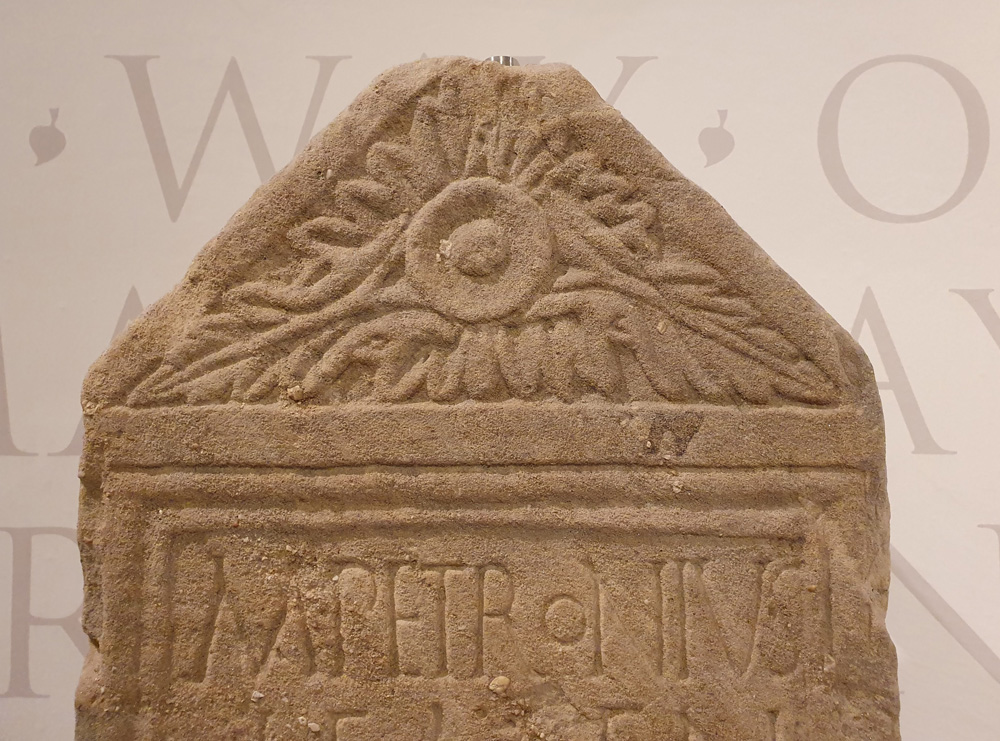
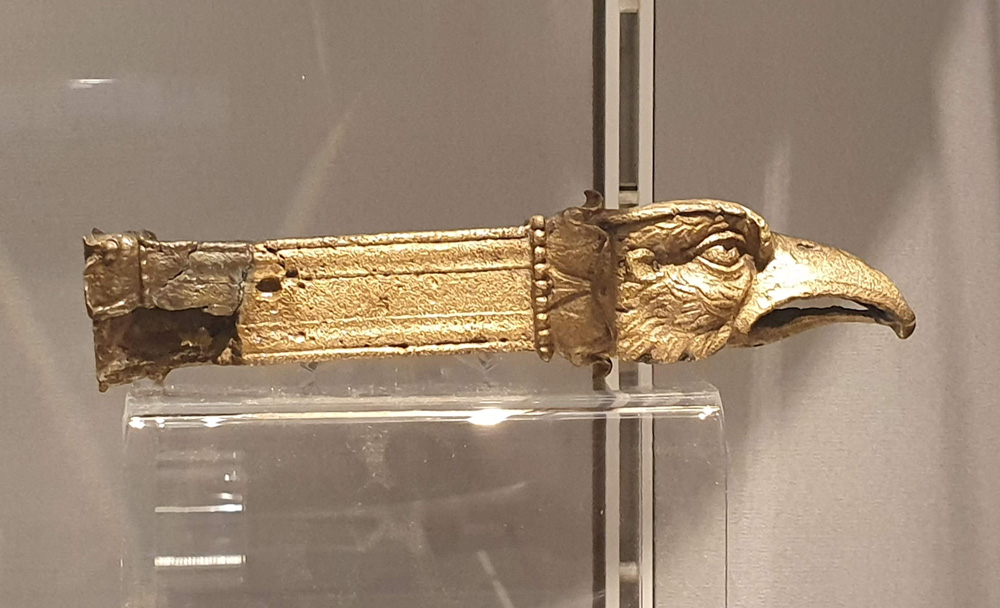
From small historic costume displays to fossils, from ceramics to family histories, a lot of ground is covered in the museum. If all the subjects will interest you, I’d allow up to two hours here, though of course you can be selective or enjoy the highlights more quickly. Coalport porcelain, demolished stately homes, local historic characters, medieval trades – a lot of what you discover here will add helpful and fascinating context to your time in the area, so I’d plan for a visit to the museum early on in your day trip or holiday.
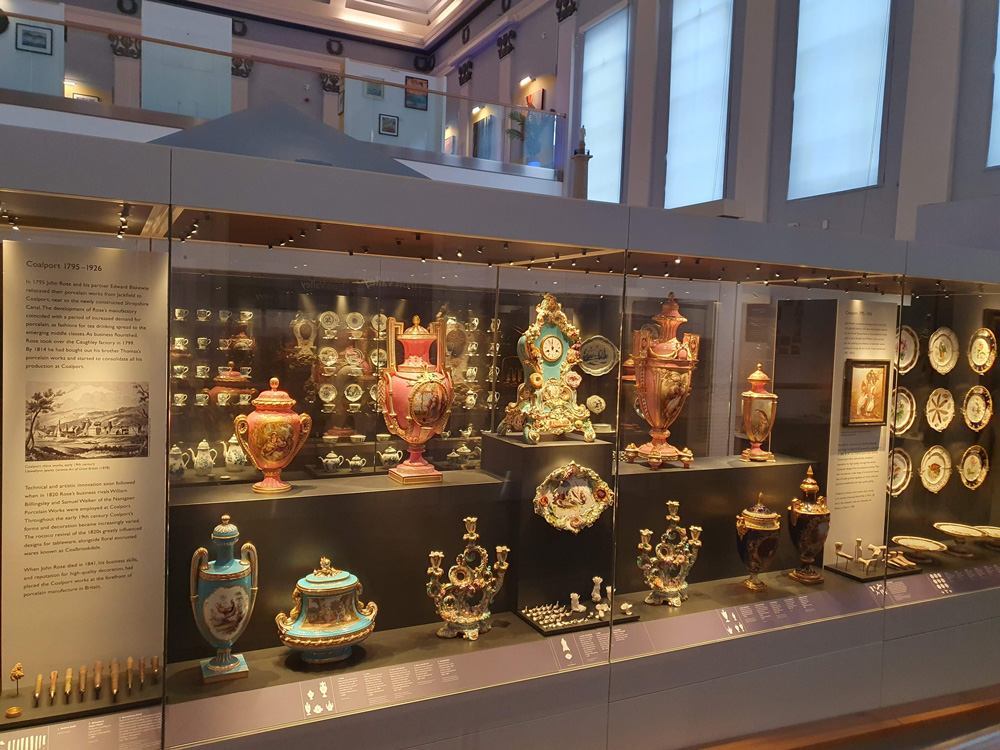
Shrewsbury Abbey is an important sight when you’re visiting town, and not just for the fans of Brother Cadfael. The heart of a Benedictine monastery from 1083 until the dissolution of the monasteries, the Abbey is now a parish church on a grand scale, squat and square and built of red sandstone. It’s easily reached on foot by crossing the English Bridge from the heart of town. The buildings and land of the monastery extended over this area alongside the river; now mostly replaced by car parks, roads and the railway line. Broken walls show where the monastery buildings extended from the surviving church, and a few other reminders are dotted around.
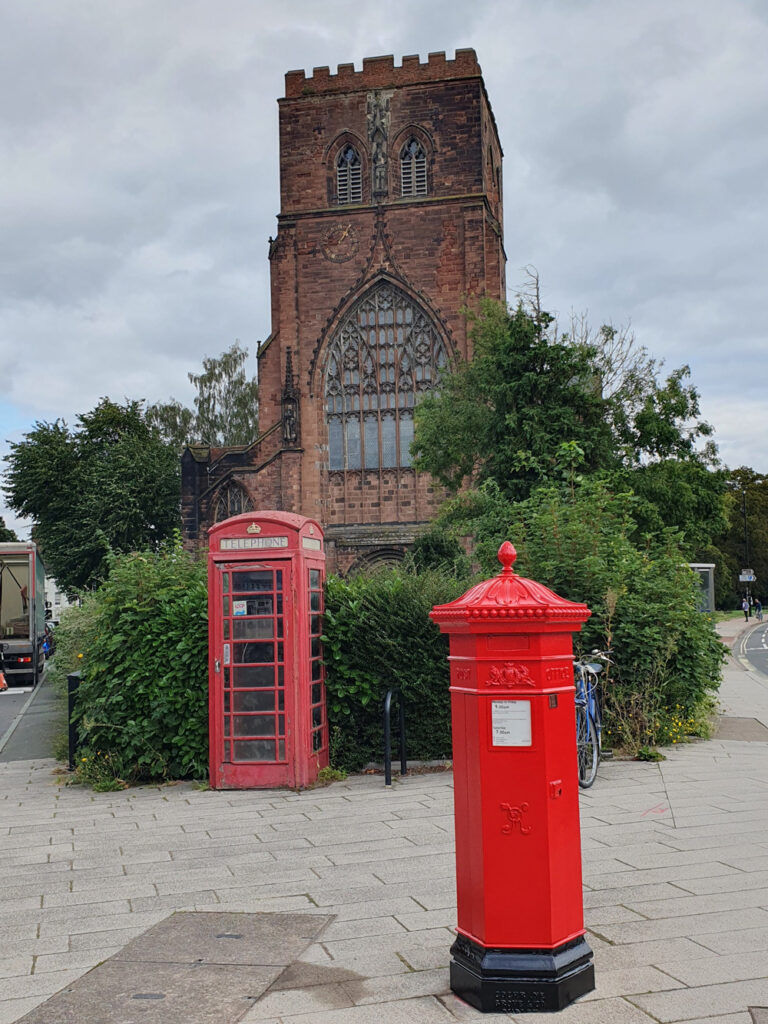
Points of interest inside the abbey include an assortment of grand tombs, mostly brought here from other churches. Over the road and standing as a surreal, solitary fragment is a stone pulpit that was once part of the refectory- in the museum you may have seen a Romantic era painting of this evocative ruin. A stone panel from the pulpit was stolen in 2022 but fortunately rediscovered hidden nearby.
Between the abbey and the English Bridge is another sight you should pop into if you have time. The HQ of the Shropshire Wildlife Trust and their Cut Visitor Centre offers a lovely green oasis, among the busy roads. With views of the abbey tower and with its orchard trees and plants, it recreates something of the tranquil atmosphere of the monastery gardens where Brother Cadfael and his real-life counterparts would have worked and prayed. In this little complex is one of the monastery’s infirmary buildings, a picturesque reminder of the scale of the nearly-vanished monastic world here in Shrewsbury. There are children’s activities here and also a good shop for nature and Shropshire lovers – I was delighted to find an excellent laminated guide to wildlife in the Shropshire hills.
Shrewsbury Castle, though historically important, is not as dramatic to visit as, say, Ludlow Castle. However, within its sandstone walls (free to enter) is a pleasant green garden, and a path on the right leads up to Laura’s Tower, a visitable tower with some views – though sadly these don’t extend to the town centre. In the main castle building is a military museum (admission charge). Outside the castle, don’t miss the wonderful timber-framed Council House Gatehouse and Gateway .
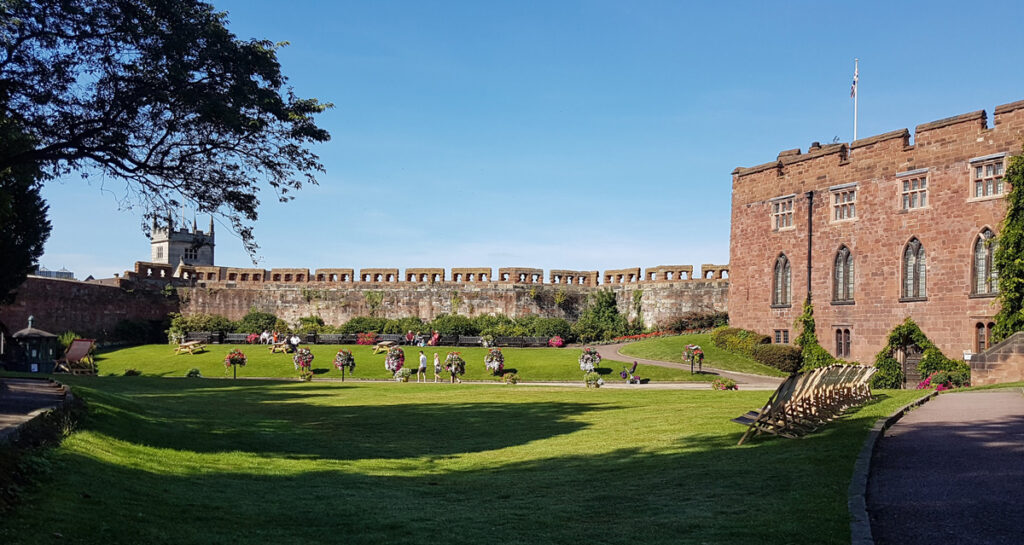
Over the road from the castle is Shrewsbury Library, another very fine building, which was previously the home of Shrewsbury School, founded in the 16th century. Outside is a statue of local hero Charles Darwin and also a bust of Shropshire author Mary Webb.
When you’re ready for a break from streets and buildings, it’s time to head to the Quarry, a large area of grassy park in the curve of the Severn. This open area is a good place to stroll along a riverside walk, admire the 1923 Porthill Footbridge, a suspension bridge, or enjoy a picnic. The highlight of the Quarry, though is the Dingle. This is a rather breathtaking hidden sunken garden with a small lake, fountain and lavish plantings – an extravagant riot of colour during flowering seasons, and an attraction close to Shrewsbury’s heart.
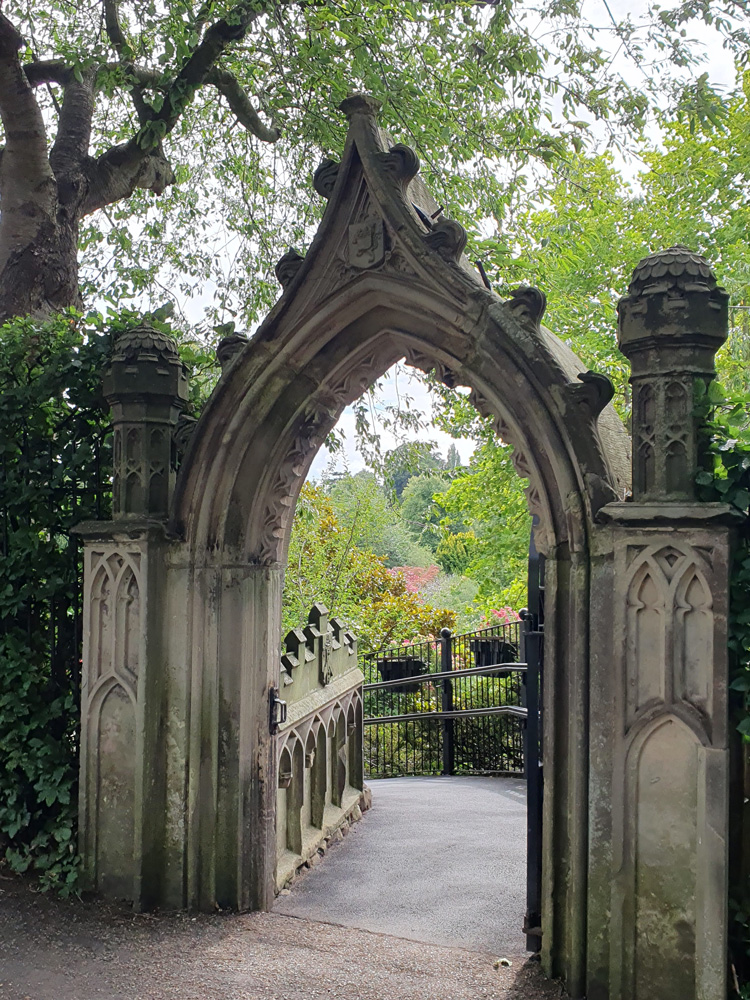
If you have longer in town, or different priorities, you could enjoy a relaxing boat ride on the river or for a darker vibe, a guided tour of the old Shrewsbury Prison, where activities on offer include an escape room and ghost tours. Art trails and historic buildings walking tours add an extra cultural element to a short stay. Shrewsbury has several churches worth visiting, and one of the best is St Mary’s. This atmospheric medieval church, kept open to visitors by volunteers, is gloriously lit by stained glass windows. Not created for this church, but mostly moved here during the 19th century, they form an artistically important collection, the highlight of which is the huge and colourful Jesse window filled with Old Testament figures.
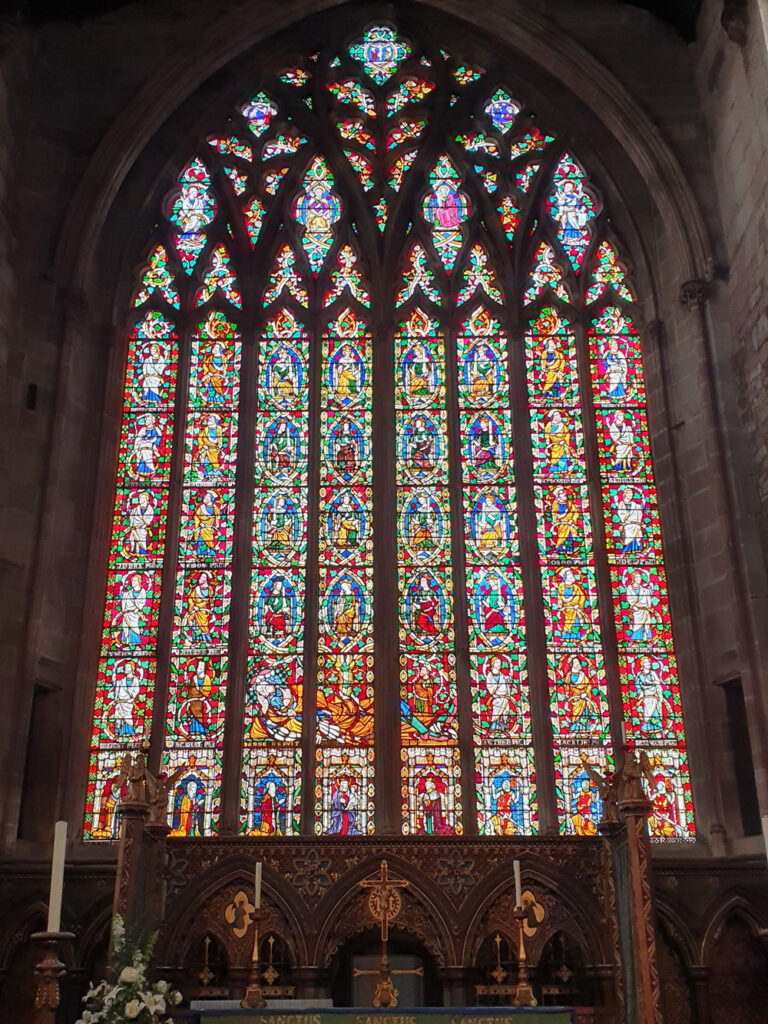
Once you’ve ticked off the sights that interest you the most, the best way to enjoy Shrewsbury is to explore on foot. I was charmed by a walk from St Chad’s Church (a handsome, circular Georgian church in a classical style where Charles Darwin was baptised) along the town walls towards the English Bridge. The stretch of street called Town Walls follows the line of the top of the old defensive walls, passing a picturesque historic tower, fine terraced houses and a Georgian crescent, and offering views over green sports fields to the river. Immediately below the walls are small green allotments where fig and apple trees grow. Other walking routes could take you along the river banks, or through Shrewsbury’s shopping heart, up Pride Hill, via the modern Market Hall or down pretty shop-lined Wyle Cop.
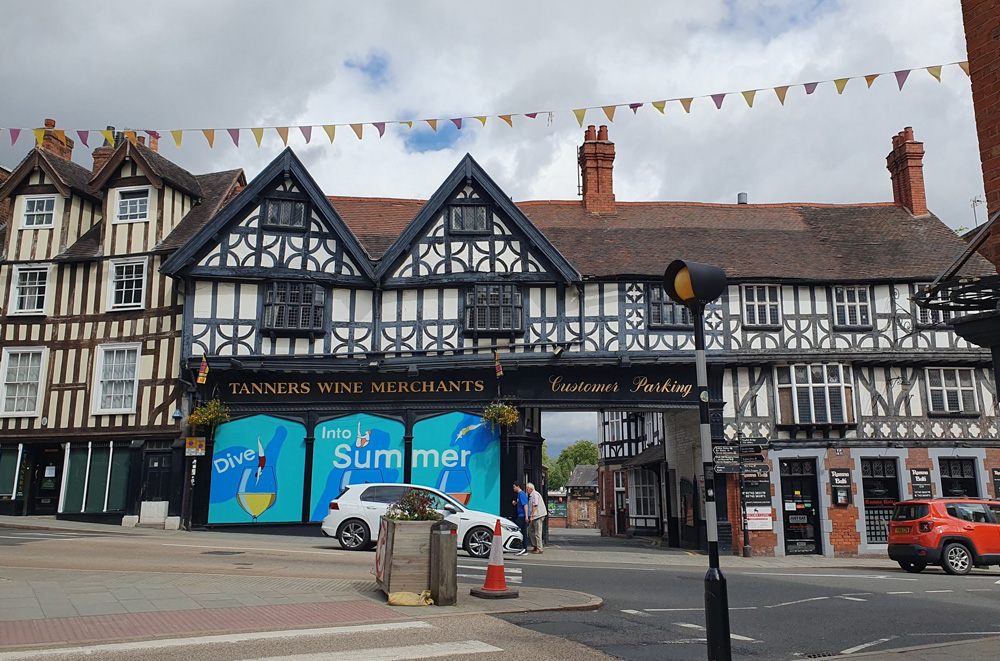
Day trip or longer stay?
I most recently visited on a day trip and had an excellent, full day, although I didn’t have enough time for everything I wanted to do. Limited opening hours (e.g. 10:30-4) can make it hard to fit many tourist attractions into one day. On a previous visit during the folk festival, with morris dancing displays throughout the town centre, we had a fantastic time watching dance at various scenic locations and didn’t fit in ‘tourist sights’ at all. Generally speaking, though, with just a few hours in town, you could walk around the principal streets, visit the museum, Dingle, castle garden, abbey and perhaps a church or two as well as having a sit-down with refreshments. Enough for a great day out, even if does leave you wanting more.
Two or three days would offer a generous amount of time to see the sights and enjoy the town centre’s shops, cafés and hospitality. You’d have time for leisurely meals and maybe a trip further afield. And with a longer stay of five or more days you could really make a start on discovering the area, with excursions to some of the most interesting and attractive sights of Shropshire and the neighbouring part of Wales.
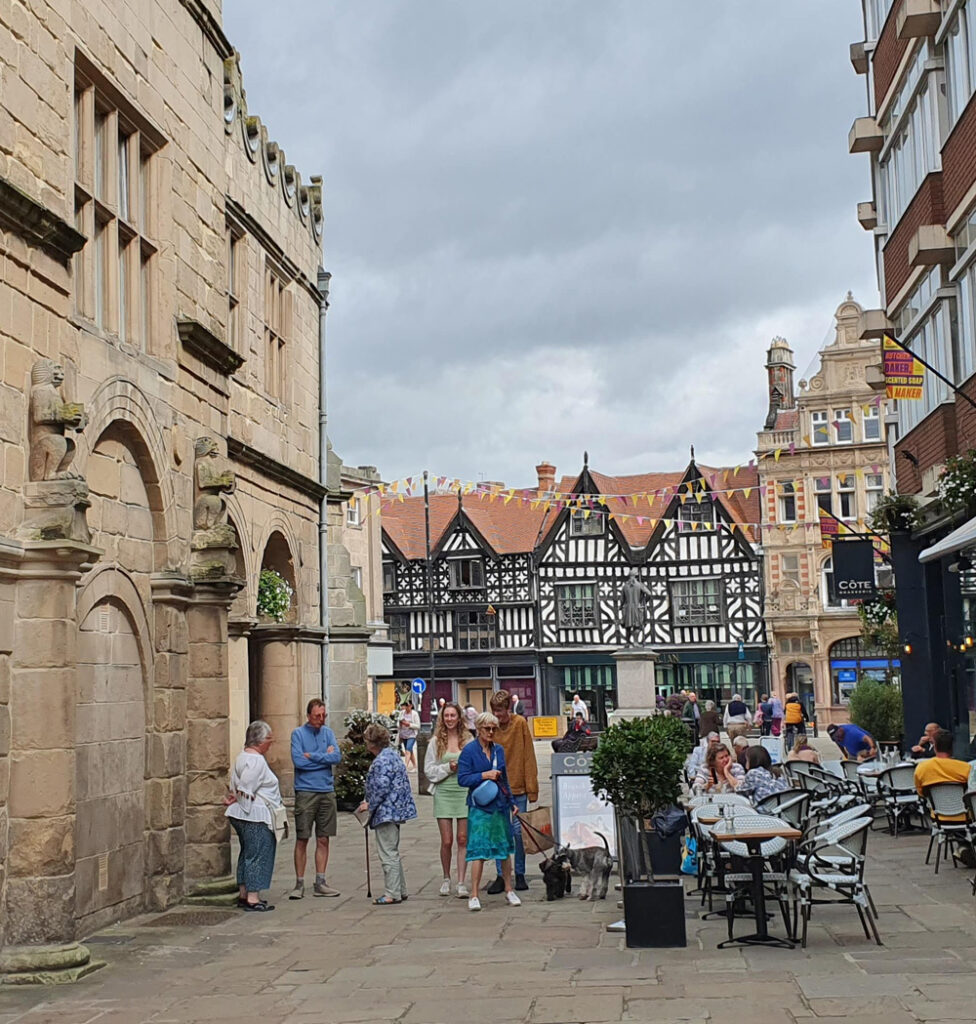
Where to stay in Shrewsbury
For the best experience of pottering around the pretty historic streets and popping into Shrewsbury’s cafés, restaurants and shops, I’d recommend staying in the centre of town. A central location will offer the most charm as well as being convenient and practical, especially if you’re travelling by public transport. If arriving by train, it’s worth noting the distance on foot from the railway station – you may prefer to stay on this side of the centre, particularly if you’ll be making trips out of town. Otherwise, taxis are available to take you from the station to your accommodation.
If you are driving and staying in the historic centre, check whether private car parking is available before you make a booking – some accommodation may not have space, so in this case you would need to use one of the town’s public car parks. You may find it preferable to stay just outside the town centre for ease of access and parking.
The best places to stay include:
- RHUBARB at Drapers Hall – contemporary accommodation in a historic setting in the heart of town
- Darwin’s Townhouse – a popular B&B in a Georgian building on the edge of the town centre
- Attic & Cherry Tree Guest Suites – a guest house with excellent reviews, just outside the town centre (an easy walk) and near the Abbey
- Anton Guest House B&B – another good B&B option with good breakfasts, a short walk from the town centre.
- Holiday lets: you’ll find a good selection of flats and houses to rent for one or more nights (some may require a minimum stay), which make a good option if you’re wanting an independent stay. Check location and the arrangements and timings for checking-in. Good options at the time of writing include Abbey Cottage, a characterful two-bedroom cottage; the flouncily-elegant Church Apartment, a studio with a little walled garden; and the central, stylish Pass the Keys Art Deco Inspired Apartment with Rooftop Views.
- More places to stay in Shrewsbury
Outside Shrewsbury. Tempting options for travellers with cars include:
- Hawkstone Hall Hotel & Gardens – stately home accommodation 12 miles from Shrewsbury, ideal if you want to visit Hawkstone Park Follies
- Upper Eyton Farmhouse B&B – a welcoming and homely B&B offering a rural option in easy reach of the attractions of Shrewsbury
- Riverside Inn – a popular choice in an attractive waterside setting between Shrewsbury and Ironbridge (so handy if you want to visit both sights)
- Pelham Grove – a comfortable and welcoming B&B a short drive to the south-east of Shrewsbury
Please note that these links are affiliate links and when you book using them you won’t pay more, but will be helping to keep this website online. If you’re not ready to book now, you can bookmark a link to use later. Thank you.
Run your own search for the latest prices and availability – and don’t forget to check recent reviews:
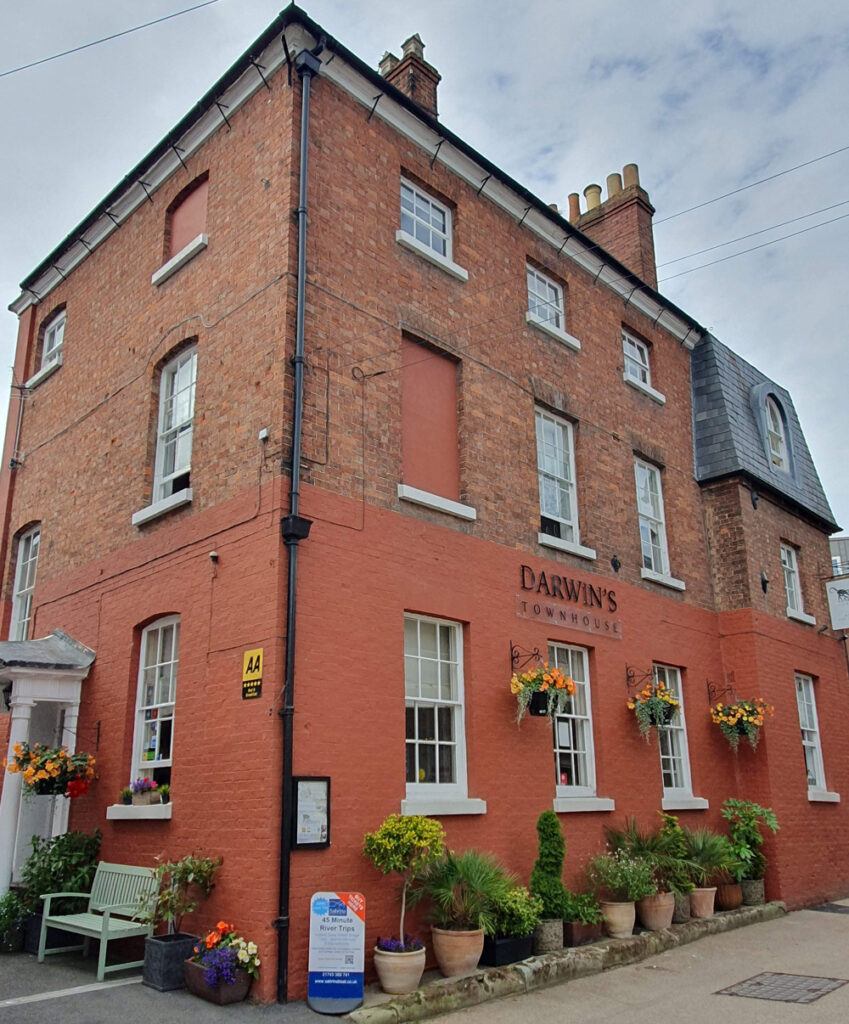
When to visit
For the most enjoyable experience of strolling around the centre and exploring the surrounding countryside, of course the summer months of June to early September are best. But as the town includes undercover attractions like the museum, cafés and shops, you could enjoy a short break here all year around, from an Easter getaway to a Christmas shopping weekend. The August bank holiday weekend is busy but lively, as Shrewsbury Folk Festival fills the streets with music and dance. In summer, the Shrewsbury Flower Show is a big and colourful event. Shrewsbury Food Festival is another annual celebration offering added reasons to visit.
Eating and drinking
As well as the usual high-street chains – including what might be the most attractively-housed Costa Coffee branch in the country – Shrewsbury has a really good selection of independent local food and drink businesses. I enjoyed the old-school vegetarian/vegan GreenHouse Café, with its light-filled upper-floor space and good-value lunches. Other popular options at the time of writing include Italian restaurant La Dolce Vita, and café-restaurant CSONS for locally-sourced ingredient and interesting dishes. There is a very wide range of options, though, so I’d recommend taking a look at the latest ratings on Google Maps or TripAdvisor – or simply strolling around the streets and discovering the menu and ambience that suits you best.

I also enjoyed a delicious Italian-style gelato from Gelatistry on St Julian’s Crescent (near the English Bridge) – highly recommended.
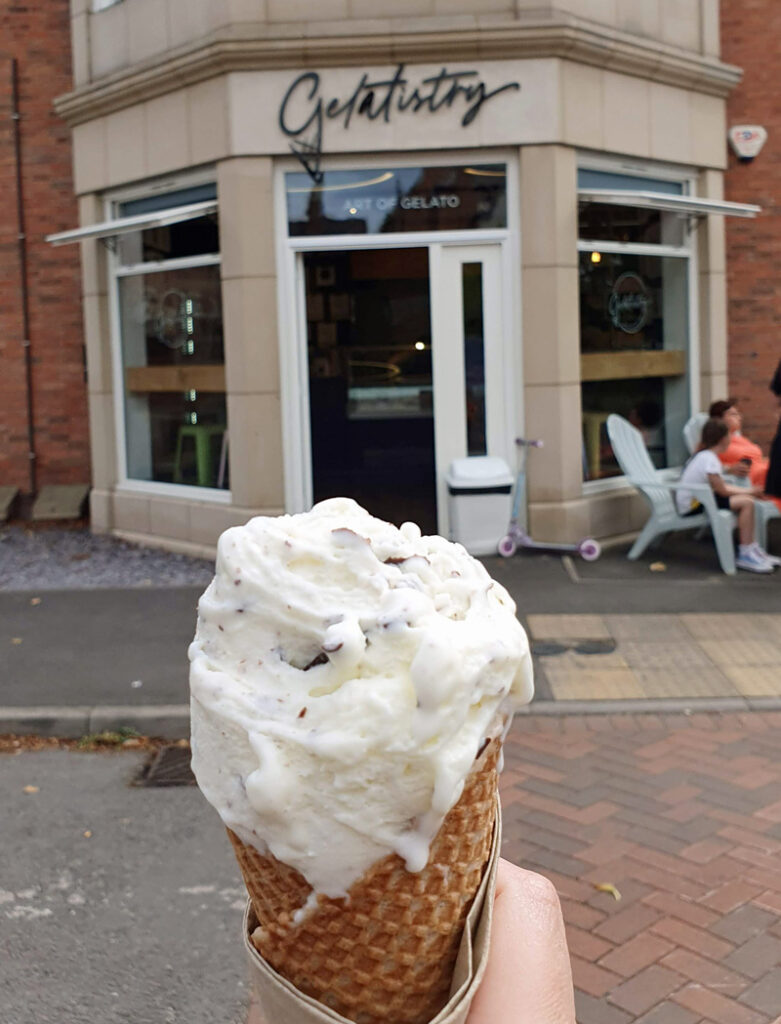
Read more
- Excellent local resource with detailed information and up-to-date events listings for Shrewsbury: Original Shrewsbury
- Shrewsbury Museum and Art Gallery
- The history of Ironbridge (video): Iron Bridge: 10 Places that made England
- English Heritage in Shropshire
- National Trust in Shropshire and Staffordshire
- Shropshire (Slow Travel) – Bradt guide (affiliate link)
- Brother Cadfael books and DVDs (affiliate link)
- Book accommodation in Shrewsbury (affiliate link)
